Germotiva
Minor Hero
  Alter Mann über 50 aus Deutschland
Alter Mann über 50 aus Deutschland
Posts: 90
|
Post by Germotiva on Jan 12, 2023 6:58:20 GMT -5
That is a very thick amount of rockwool !! That's about 2 feet thick, so now I understand what you meant when you were using 245 inches, which was meant to be 24.5 inches. Regarding REW Waterfall settings, I will use the default settings for the most part. I did this yesterday and think things show up well. Next one I post I will list the settings I change from default. Also, I use 45-100dB because my noise floor is just under 45dB a lot. Also, I'm learning about Spectrogram and what to look for, which is very informative. Hi, yes is a lot of mass. But to tame the modal wave in space, there is no way around it. Unless you use air spaces. I look and calculate with the absorber calculator (Multi Layer). This reduces the mass but not much the depth. Why I use 2 sides of the damping. Firstly to tame the multisubs and secondly to tame the mains and surrounds additionally. I deal in the home theater with the additional location bass. I work with the bassmanagment in the dsp. I put close to the surrounds the subs. These work with LFE in the group. In addition, the individual sub gets the signal info of the locations. I mix both like you in the mini dsp. Only individually refined. This gives a great atmosphere in the location. Yes I also dealt with the spectogram 2-3 years ago when I built Limp absorbers. From this you can see the WTF from above. I always looked at the holes / islands from above for the test. Since from the front these were not visible and were hidden. But as I see I still have to learn much much more to be able to understand some better, because this hides a lot of information. Here are some old measurements. Unfortunately, I did not notice the scale on the right which is set incorrectly in the standard. Also here should be scaled-60db. View AttachmentView AttachmentView AttachmentWhen the measurements and changes of multisubs are set. I always look at the even roll off. From the subs, midbass, main, etc. This is very important to get a good addition in the cut point. Here are the midbasses from 4x12“ the front (2Left,2right). Center coming soon. I‘m Building there, jet.   Here the marrying of both ways, Subs and 12“ Midbass  Groupdelay and time pulse and phase. I need to look into this in more detail to better understand the relationships. My English is very bad to understand everything in REW correctly. I have to do everything with translator. English videos about REW are like hell for me. 🙋♂️ Paul from Germany🇩🇪 |
|
Germotiva
Minor Hero
  Alter Mann über 50 aus Deutschland
Alter Mann über 50 aus Deutschland
Posts: 90
|
Post by Germotiva on Jan 12, 2023 7:57:10 GMT -5
Hi, yes is a lot of mass. But to tame the modal wave in space, there is no way around it. Unless you use air spaces. I look and calculate with the absorber calculator (Multi Layer). This reduces the mass but not much the depth. Why I use 2 sides of the damping. Firstly to tame the multisubs and secondly to tame the mains and surrounds additionally. I deal in the home theater with the additional location bass. I work with the bassmanagment in the dsp. I put close to the surrounds the subs. These work with LFE in the group. In addition, the individual sub gets the signal info of the locations. I mix both like you in the mini dsp. Only individually refined. This gives a great atmosphere in the location. Yes I also dealt with the spectogram 2-3 years ago when I built Limp absorbers. From this you can see the WTF from above. I always looked at the holes / islands from above for the test. Since from the front these were not visible and were hidden. But as I see I still have to learn much much more to be able to understand some better, because this hides a lot of information. Here are some old measurements. Unfortunately, I did not notice the scale on the right which is set incorrectly in the standard. Also here should be scaled-60db. View AttachmentView AttachmentView AttachmentWhen the measurements and changes of multisubs are set. I always look at the even roll off. From the subs, midbass, main, etc. This is very important to get a good addition in the cut point. Here are the midbasses from 4x12“ the front (2Left,2right). Center coming soon. I‘m Building there, jet. View AttachmentView AttachmentHere the marrying of both ways, Subs and 12“ Midbass View AttachmentGroupdelay and time pulse and phase. I need to look into this in more detail to better understand the relationships. My English is very bad to understand everything in REW correctly. I have to do everything with translator. English videos about REW are like hell for me. 🙋♂️ Paul from Germany🇩🇪 Here are some old measurements of phase, impulse, groupdelay of the midbasses.    I don't understand it, but I can read whether they match.😂😂 I have 2 years ago but stopped working with REW, because my HT setup was not complete. Now I have everything together and just rebuild the setup. I still need to buy a used laptop and waiting for the new UMIK-X. Only then I deal intensively with REW again. Many new videos of REW and findings have surfaced and coincide with my amateurish findings. Only the condition and simple work with REW is missing to me. With the new UMIK X I also hope for a relief in terms of measurements and understanding. Also the Magnepan LS I take more exactly into consideration thereby. To capture the better sweetspot and radiation of the speakers in height, tilt and angle. With stacked mics from the UMIK set to get at the money place faster measurement result. |
|
Germotiva
Minor Hero
  Alter Mann über 50 aus Deutschland
Alter Mann über 50 aus Deutschland
Posts: 90
|
Post by Germotiva on Jan 12, 2023 8:04:49 GMT -5
When the measurements and changes of multisubs are set. I always look at the even roll off. From the subs, midbass, main, etc. This is very important to get a good addition in the cut point. Here are the midbasses from 4x12“ the front (2Left,2right). Center coming soon. I‘m Building there, jet. View AttachmentView AttachmentHere the marrying of both ways, Subs and 12“ Midbass View AttachmentGroupdelay and time pulse and phase. I need to look into this in more detail to better understand the relationships. My English is very bad to understand everything in REW correctly. I have to do everything with translator. English videos about REW are like hell for me. 🙋♂️ Paul from Germany🇩🇪 Here are some old measurements of phase, impulse, groupdelay of the midbasses. View AttachmentView AttachmentView AttachmentI don't understand it, but I can read whether they match.😂😂 I have 2 years ago but stopped working with REW, because my HT setup was not complete. Now I have everything together and just rebuild the setup. I still need to buy a used laptop and waiting for the new UMIK-X. Only then I deal intensively with REW again. Many new videos of REW and findings have surfaced and coincide with my amateurish findings. Only the condition and simple work with REW is missing to me. With the new UMIK X I also hope for a relief in terms of measurements and understanding. Also the Magnepan LS I take more exactly into consideration thereby. To capture the better sweetspot and radiation of the speakers in height, tilt and angle. With stacked mics from the UMIK set to get at the money place faster measurement result. And here the 4 Subs….30cm Left and Right from the masterplace Point. I will work more on it later. And I still have to learn a lot to better understand some things and with REW. Therefore I am glad to have found a topic here. Good job ttocs, keep it up.     |
|
KeithL
Administrator   
Posts: 10,256
Member is Online
|
Post by KeithL on Jan 12, 2023 10:37:29 GMT -5
Yes... it gets very complicated. However, not to be a killjoy, but I think it would be overly optimistic to hope that "someday someone will come up with a reliable formula". Every room is different. And every subwoofer itself is different. And every subwoofer is going to act differently at different spots in the room. And they're all going to interact with each other. And, unless you're hanging from a balloon, all of those subs are within a fraction of a wavelength of each other, and of a bunch of walls. There are simply far too many variables for there ever to be a single solution that can compensate effectively for all of them. If you really want to go crazy then consider a vertical stack of identical subs, located in a corner, going from floor to ceiling. Or for the sake of symmetry, two such stacks, in either the two front, or two rear, corners. By using line sources, going the full height of the room, you simplify the interactions with the floor and ceiling... And, by putting them in corners, you simplify the wall interactions a bit too... It makes a big difference as to the order and combination of locations. I've tried 2-stacks and 3-stacks where I align each stack to itself - as in your groupings, then align the front two stacks together, then add another single sub or stack of subs in the back of the room, or in one scenario, just behind the sofa. The results vary quite a bit. I have not yet tried L1+B1, and then add L1B1+R1, then do the same with Level-2, and then sum both levels together. But I want to try this and the reverse of it to see if I can tailor the left subs' weaknesses a bit better. There's also Inverting that can be added in the mix - which I try as a matter of course with every alignment step, as well as some PEQ within miniDSP. Also, one can run Dirac, get results that make it difficult to get good crossover blending, and then try inverting the phase to see if it works better, which I plan to do soon with this latest setup. So there seems to be quite a few options during aligning, after aligning, and even after creating Dirac filters - as you know! Lots of ways to skin cats, if that's even a thing anymore. Right now I'm just wanting to document some REW ideas to share what I know of the app and to gather more info from others about other features I have yet to know how to use. In the process I've been learning about things I haven't been able to read about elsewhere. A few years ago when I first began using REW I scoured the Triple-W trying to even just get started, and failed for a long time until I learned that I could just use my Mac connected directly to the processor via HDMI. Duh, who knew? I was using an audio interface and setting the controls manually for each REW session, which was tedious to say the least. Thanks for the info! It's interesting... I think I've seen/read where folks say the order (probably) doesn't really matter. It certainly makes more sense that it would make a difference, like you've determined. I'm guessing someone will eventually figure out a somewhat reliable formula for determining a good order for this kind of alignment. Maybe based on the relative phase differentials at MLP for each individual measurement, or something crazy like that. With 6 subs, if my brain is working right, I think you have like 360 different potential combinations (6 factoral / 2)?!?! Even if I'm wrong, it's still a lot!
I think I'm glad I only have 2 subs  |
|
|
|
Post by Natural1 on Jan 12, 2023 12:45:35 GMT -5
Yes... it gets very complicated. However, not to be a killjoy, but I think it would be overly optimistic to hope that "someday someone will come up with a reliable formula". Every room is different. And every subwoofer itself is different. And every subwoofer is going to act differently at different spots in the room. And they're all going to interact with each other. And, unless you're hanging from a balloon, all of those subs are within a fraction of a wavelength of each other, and of a bunch of walls. There are simply far too many variables for there ever to be a single solution that can compensate effectively for all of them. If you really want to go crazy then consider a vertical stack of identical subs, located in a corner, going from floor to ceiling. Or for the sake of symmetry, two such stacks, in either the two front, or two rear, corners. By using line sources, going the full height of the room, you simplify the interactions with the floor and ceiling... And, by putting them in corners, you simplify the wall interactions a bit too... Thanks for the info! It's interesting... I think I've seen/read where folks say the order (probably) doesn't really matter. It certainly makes more sense that it would make a difference, like you've determined. I'm guessing someone will eventually figure out a somewhat reliable formula for determining a good order for this kind of alignment. Maybe based on the relative phase differentials at MLP for each individual measurement, or something crazy like that. With 6 subs, if my brain is working right, I think you have like 360 different potential combinations (6 factoral / 2)?!?! Even if I'm wrong, it's still a lot!
I think I'm glad I only have 2 subs  You're not being a killjoy at all. It's super complex, and to be fair I did say "somewhat reliable". It's fun to think about, and I certainly can't solve it. Maybe you're exactly right in that there are just too many variables to use for predictive purposes, and the only real solution is brute force iteration. Thankfully computation is relatively cheap. |
|
ttocs
Global Moderator    I always have a wonderful time, wherever I am, whomever I'm with. (Elwood P Dowd)
I always have a wonderful time, wherever I am, whomever I'm with. (Elwood P Dowd)
Posts: 8,146
Member is Online
|
Post by ttocs on Jan 12, 2023 12:45:43 GMT -5
KeithL brings up an interesting point about line array subs. I revisited some REW measurements I did last March when I stacked six subs. I did very little alignment stuff, mostly just played with Phase settings on the subs themselves. But, I was comparing some things just now and see that Group Delay becomes lower just by stacking the subs and creating an array. Something to be said about this, and worth more time to learn about. I am learning more about REW Spectrogram and thought I'd show a quick comparison of something I did in the last couple days. I aligned the same subs in the same locations using two different strategies. The six subs are in three stacks of 2 each. So I aligned L1 (bottom) and L2 (top) subs together, then did the same with R1 and R2, and then with B1 and B2 (Back stack). Then the three aligned sums were further aligned, L12+R12, and finally, L12R12+B12. This is what I am calling the Vertical Alignment. The other alignment is what I am calling Horizontal Alignment. This is LRB123+LRB123 (LeftRightBackBottom+LeftRightBackTop). Here are the Spectrograms of both. It should be pretty easy to distinguish that the Horizontal Alignment version has a better Spectrogram (neither are great, but a lot better than things were a year ago). The Cursor line is at 20ms, which as I learned yesterday is about where that dotted line should be below at 100Hz. Also, a great Spectrogram would show that all the dwindling energy should be extinguished by about 400ms, which mine do not show, but, the Horizontal alignment is an improvement vs the Vertical alignment. 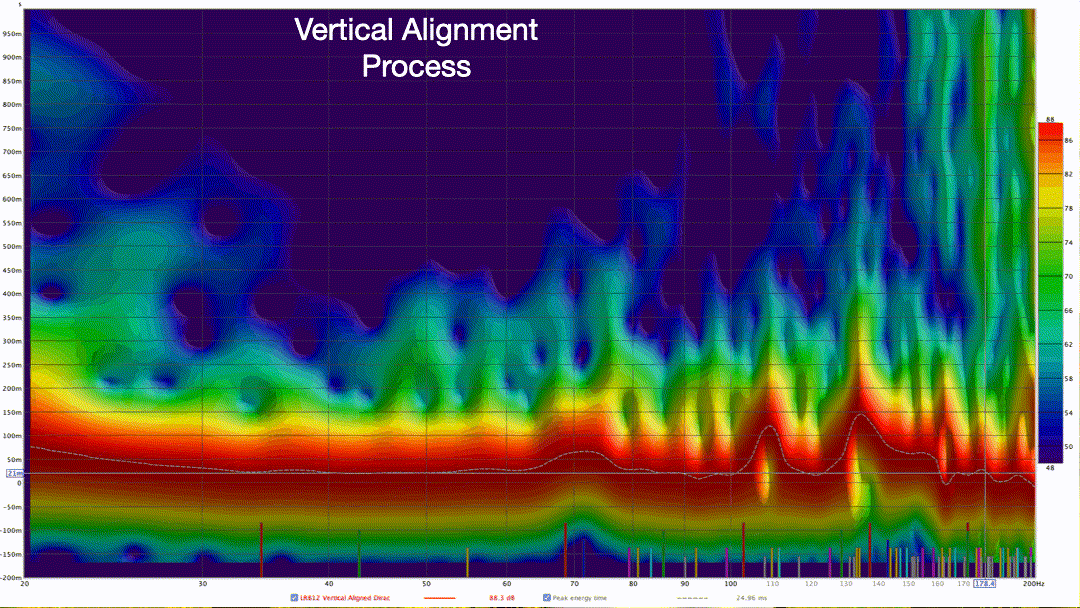 This is not to say one method is better than another, but that each method has different needs and I certainly found it simpler to achieve a better result quicker with the horizontal method of the alignment process.
|
|
Germotiva
Minor Hero
  Alter Mann über 50 aus Deutschland
Alter Mann über 50 aus Deutschland
Posts: 90
|
Post by Germotiva on Jan 12, 2023 15:03:34 GMT -5
This is not to say one method is better than another, but that each method has different needs and I certainly found it simpler to achieve a better result quicker with the horizontal method of the alignment process. Exactly it is not about which method is the best. But which method can select someone on his room and which are there at all. Not every room is the same. And the acoustic physics always behaves differently to the dimension and to the aligned place. Not everyone sits symmetrically in a symmetrical room. ttocs sits asymmetrically. Germotiva (me) already sits symmetrically in the listening room but in an L room. Are the rooms closed or open, all aspects and irregularities. More important I find the approach of the various viewers and users as they try to create the best of it. Simply show the own point of view for others who may face the same problems. And not to say here my method is better than yours. Some things or procedures may go in the same direction to get to a good and satisfied result. Only the diversity with solutions brings humanity forward. Even if they do not speak the same language. 🙋♂️ Old man from 🇩🇪 |
|
ttocs
Global Moderator    I always have a wonderful time, wherever I am, whomever I'm with. (Elwood P Dowd)
I always have a wonderful time, wherever I am, whomever I'm with. (Elwood P Dowd)
Posts: 8,146
Member is Online
|
Post by ttocs on Jan 12, 2023 15:20:14 GMT -5
Germotiva I totally agree. It's by going through these exercises that I discover more and more about things I should be considering, which can lead to better results. Like using more of the tools REW has to offer, Spectrogram for example. Before yesterday I didn't know how to read what I was seeing, now I can see some of its benefits.
|
|
ttocs
Global Moderator    I always have a wonderful time, wherever I am, whomever I'm with. (Elwood P Dowd)
I always have a wonderful time, wherever I am, whomever I'm with. (Elwood P Dowd)
Posts: 8,146
Member is Online
|
Post by ttocs on Jan 13, 2023 11:45:40 GMT -5
I finally learned how to get REW's EQ stuff to work. The control to get the filters initially created was easy for me to miss, so, user error again. REW EQ is getting some pretty impressive results, even for a novice. I've got some Aligned Sum Delays entered into my spreadsheet so it's pretty quick to input those numbers into each miniDSP. Then, I'll be running Dirac for each of the alignments to check how things end up. I did one Dirac run just now and I'm very happy with the improvements made, at least, by the numbers. So I'll probably load up all six Dirac Filter Slots in the processor and compare with a lot of listening this weekend. I don't expect much difference for the differences I've seen in the measurements, but there are some tunes I play which have content below 40Hz that can be pretty noticeable when something is missing, and then there's the dynamic impact present when things are working well vs being a bit blurry. So I'll post some things about how I got EQ working and what settings were used. I frankly don't know how some are using some of the house curves with so much extra bass, because they just don't work in my room - it's too much. And Germotiva, you got me to add a lot of rockwool at the back of my room like I've been wanting to try for so long, and finally did. So I've got 38cm x 120cm x 142cm stacked on the back wall in the little alcove where my back subs are located, along with the component rack. It made enough difference that I'll keep it. |
|
Germotiva
Minor Hero
  Alter Mann über 50 aus Deutschland
Alter Mann über 50 aus Deutschland
Posts: 90
|
Post by Germotiva on Jan 13, 2023 13:45:52 GMT -5
I finally learned how to get REW's EQ stuff to work. The control to get the filters initially created was easy for me to miss, so, user error again. REW EQ is getting some pretty impressive results, even for a novice. I've got some Aligned Sum Delays entered into my spreadsheet so it's pretty quick to input those numbers into each miniDSP. Then, I'll be running Dirac for each of the alignments to check how things end up. I did one Dirac run just now and I'm very happy with the improvements made, at least, by the numbers. So I'll probably load up all six Dirac Filter Slots in the processor and compare with a lot of listening this weekend. I don't expect much difference for the differences I've seen in the measurements, but there are some tunes I play which have content below 40Hz that can be pretty noticeable when something is missing, and then there's the dynamic impact present when things are working well vs being a bit blurry. So I'll post some things about how I got EQ working and what settings were used. I frankly don't know how some are using some of the house curves with so much extra bass, because they just don't work in my room - it's too much. And Germotiva , you got me to add a lot of rockwool at the back of my room like I've been wanting to try for so long, and finally did. So I've got 38cm x 120cm x 142cm stacked on the back wall in the little alcove where my back subs are located, along with the component rack. It made enough difference that I'll keep it. Yes the EQ functions are very good from REW. First attempts have not worked for me either...   Did not pursue this further. But I still want to learn, because this saves a lot of time and the results can be transferred. Glad to hear ttocs that you like it and there are improvements coming from it. Remember and a tip, there are different stone wool. Always consider the flow resistivity (Pa.s/m2) the lower the better in bass. There are many applications and setups that act on certain frequency and lead to a good result. Also playing with the air behind it allows to reduce the strength of rockwool. I always use the www.acousticmodelling.com/8layers/porous.php . With it you can play nicely. There is a simple way or a multilayer function.  |
|
ttocs
Global Moderator    I always have a wonderful time, wherever I am, whomever I'm with. (Elwood P Dowd)
I always have a wonderful time, wherever I am, whomever I'm with. (Elwood P Dowd)
Posts: 8,146
Member is Online
|
Post by ttocs on Jan 14, 2023 19:06:34 GMT -5
Taking a break for a little while. I was chasing my tail a little bit with reasoning out how to work with the delays that REW reports via the "Use Acoustic Timing Reference" feature. It's a bit inconsistent, and I've known that for a long time, but REW does so many things in a miraculous way that I have been trusting it implicitly this week just to see where it leads to. Well, I'm back to using my judgement on some of the timing stuff. Still working through it, but it may well be that I don't use any delay for both subs in one stack (even though REW measures a timing difference).
I'm also trying different filter adjustments to see what gets affected. This led me to the current task of zeroing out all the subs, measure each one, create a correction filter for each one, then Align each stack of two subs together and measure that, then take that combined measurement and create a filter for the pair of subs in one stack, then move on to the next stack and repeat the process. I just finished one stack and I'm hoping it's a better starting point to use each stack as a virtual single sub.
Yesterday, I'd finished yet another test of an alignment scenario that measured great, and sounded very good before using Dirac, but sounded really blurry and ill defined with the Dirac filter, and the Dirac filter measured very well, just sounded bad. So this is more evidence that we can have a setup that measures well but doesn't sound that way.
|
|
ttocs
Global Moderator    I always have a wonderful time, wherever I am, whomever I'm with. (Elwood P Dowd)
I always have a wonderful time, wherever I am, whomever I'm with. (Elwood P Dowd)
Posts: 8,146
Member is Online
|
Post by ttocs on Jan 15, 2023 20:50:59 GMT -5
To sort of quote Mr Bookman, the Library Cop on Seinfeld, I've been all over this Alignment thing like a pit bull on a poodle! And I've made some pretty amazing progress that I'll share, but it'll take a week or so to put the thoughts and graphics together to make it intelligible.
The short story is that I have tried various methods of using the delay numbers that REW reports, but I get inconsistent results no matter how these are used. So today I looked solely at IMPULSE for each subwoofer and got great results!
I've gotten great results like this when using the Speaker Level Inputs on my subs to use them with no correction as extra woofers for my main speakers. So, no outboard DSP, no Dirac. Just Reference Stereo. The sound was fabulous, but this didn't help with getting results like I've gotten today for BM (Bass Management) or LFE.
I've gone through some phases in the last week or so. Got some pretty good results just flying by the seat of my pants and aligning just by combining measurements till they looked good, then combining more and more the same way. This gets things working pretty well and there was no "One Note" stuff, but I knew there was far more improvements to be had, so, the journey and quest for knowledge, and in keeping with the point of this thread - the sharing of that knowledge of all things REW.
STAGE 1
I measured each sub individually, looked at the Impulse for each and entered the "Ref" number, that one can see by hovering the mouse over Ref, into my spreadsheet, did the math to get delays by subtracting all subs with shorter delays than the one with the longest delay. I then inputted these delays into each miniDSP channel. These are the only delay numbers I used for this exercise.
STAGE 2
Took another round of measurements of each sub. Then aligned each stack of subs, bottom sub to top sub. So now I have three "virtual" subs to work with.
STAGE 3
Measure each of the virtual subs and use these measurements for REW's EQ module to make a PEQ filter for each of the three subs and Import these filters into each miniDSP channel. There are three filters, one for each of the three miniDSP units controlling the three virtual subs.
STAGE 4
Measure the virtual subs with the PEQ entered for each. Use these measurements to then align the three into one virtual subwoofer.
STAGE 5
Use the measurement from STAGE 4 in REW's EQ module and come up with a PEQ filter that is then added at the INPUT PEQ section of each miniDSP. This is the final step before the final measurement. The measurement does indeed match the predicted target in EQ!
This new result is about as stark a comparison to the disappointment of the ONE NOTE bass I experienced last night as one could ever find. They both have TONS of bass, but one was in my head and I couldn't escape from it, and the other is super articulate bass that's extremely well defined and doesn't clutter anything else in the music. I'm now getting down to an articulate 16Hz, albeit at a greatly reduced output, about 15dB less than I get from the same song at 25dB, but still, it's at the same SPL as frequencies above a few hundred Hz.
Another note about House Curves, the Harman Curve to be precise. I simply cannot use it. So, for each EQ Stage I performed, I just used my own judgement and kept the bass pretty flat with very little tilt. I did the same with Dirac, which wanted to plus the bass over +3dB higher. So I just used a +1dB setting in Dirac for the subwoofer, same for my main speakers.
I've heard and read about "Chest Slam". This is a term that gets used quite a bit, but it doesn't properly explain enough all by itself. So while I would call what I'm hearing and feeling now as more accurate bass, there is still a lot of slam to go along with it.
|
|
ttocs
Global Moderator    I always have a wonderful time, wherever I am, whomever I'm with. (Elwood P Dowd)
I always have a wonderful time, wherever I am, whomever I'm with. (Elwood P Dowd)
Posts: 8,146
Member is Online
|
Post by ttocs on Jan 17, 2023 0:21:08 GMT -5
This is a demonstration of measurements that look good and sound really bad, and others that don't look as good and sound great. MSO, Multi Sub Optimizer, made the really good looking measurements that sound terrible. The optimization sucked the life out of the signal and left it dry, sloppy, and just plain blurry, and for good reason - it used some massive delays amongst six subs in three stacks. A stacked pair of subs should have the delays pretty close, not 20ms or more. This group of images also points out some of the many ways REW can be used to glean information from measurements. The filters made with just REW sound fantastic, but just don't look as great in some of the measurements. The Impulse and Group Delay plots are the ones that are easy to see that the measurements from the REW filters look better. The Spectrogram is a mixed bag. The Peak Energy Time line is better for the REW filters, but the other aspects look better for the MSO filters. Likewise with the Waterfall plot, the MSO version looks waaaaay better. I've never had one look near that good ever. And lastly, the LFE plot shows just how much MSO computation went into getting that plot line look so steady and smooth, as opposed to the REW version with the narrow nulls. A cleaner initial impulse looks good, and dynamic impact is better when all the channels line up nicely. The impulse for the REW version looks great because all six subs were aligned using the Impulse Response. I measured each Impulse plot, calculated the difference for each, and entered the delays into each miniDSP channel. After that, all I did with REW EQ was to adjust the EQ settings with no changes in delay or gain. I'll be posting about this in more detail next week, maybe sooner. Red is REW, Blue is MSO.  Lower is better. Smoother is better. Red is REW, Blue is MSO. 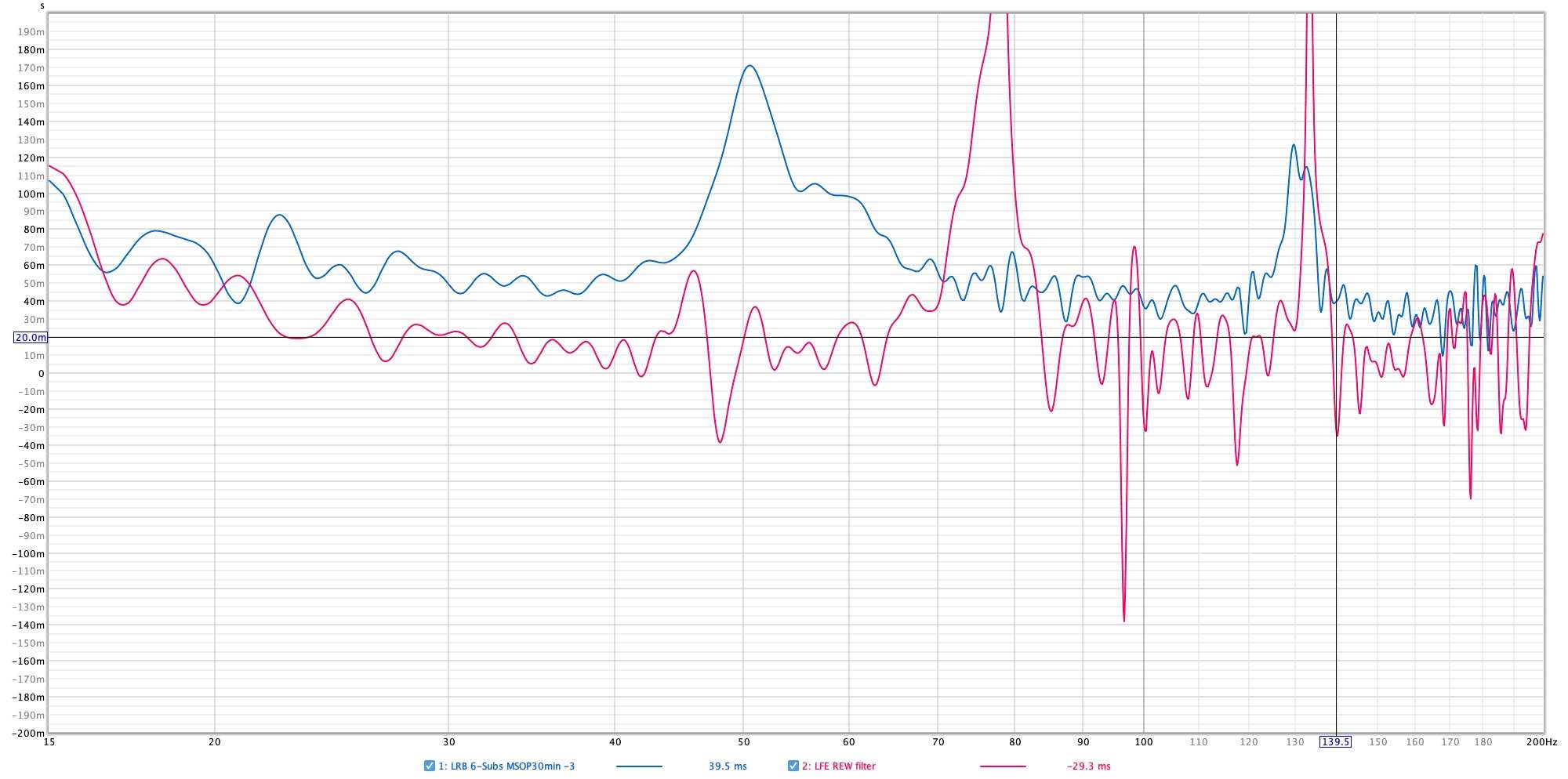 That dashed line is the Peak Energy Time line. Lower on the scale is better, like the one on the right, but that's about the only thing better about that one. The colors indicate energy level as can be seen in the scale on the right of each plot. When the energy dissipates quickly, the transition from red to dark blue takes less time as indicated with the scale on the left, less time duration is better. The left plot is MSO filters, right is REW filters. 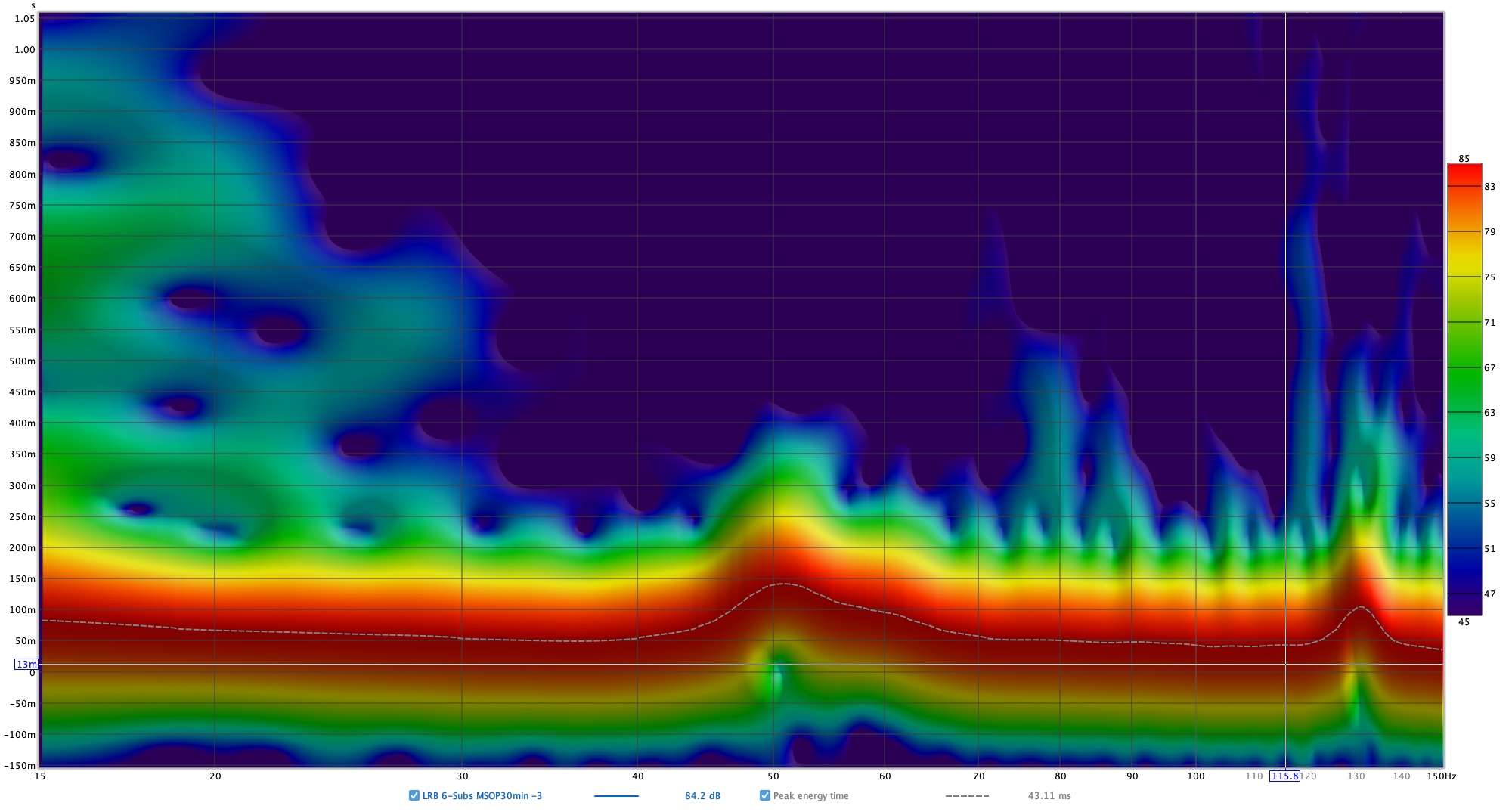 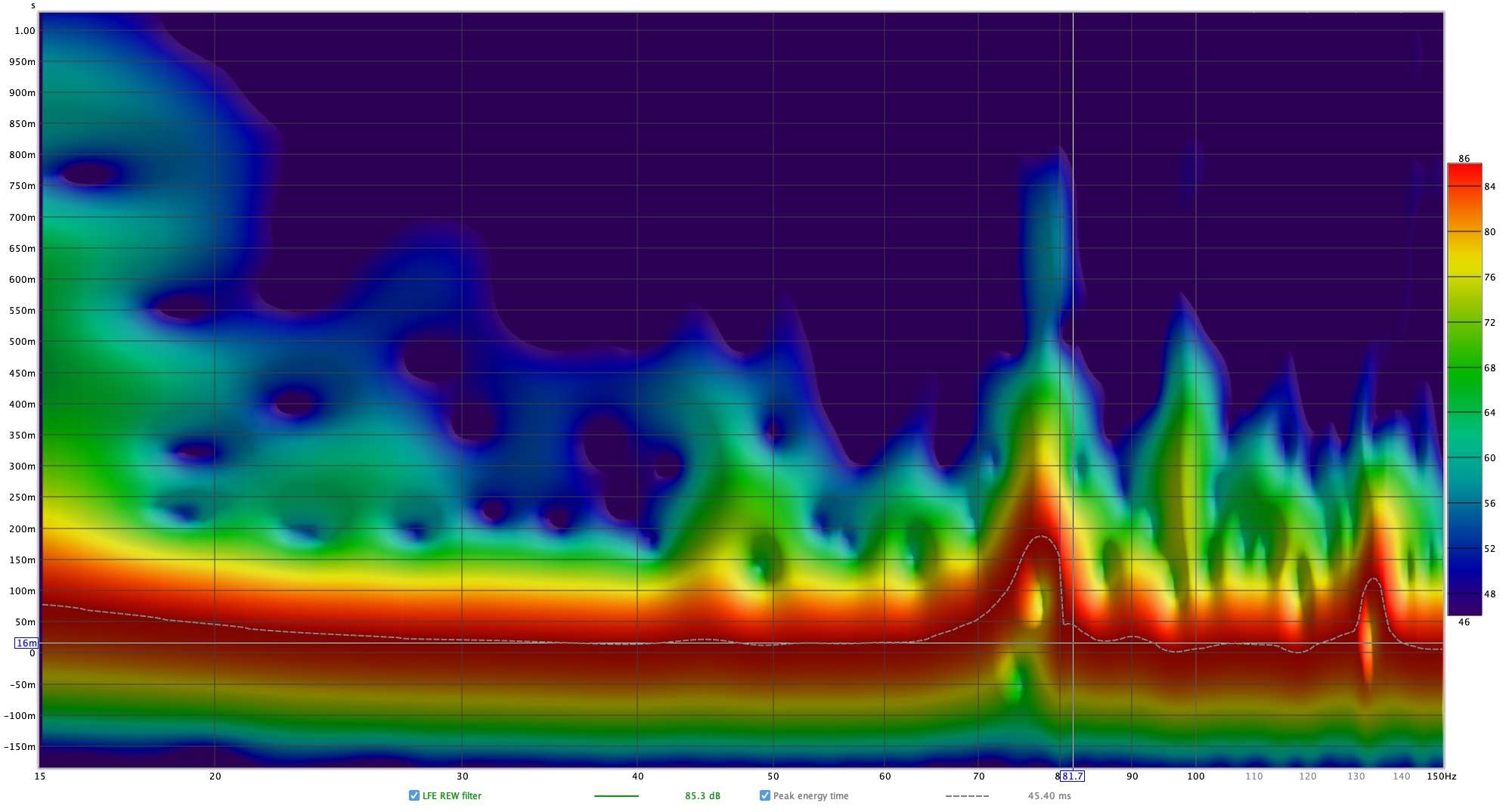 The waterfall plot on the left (MSO filters) makes it look like my room is well treated, but it's not. The plot on the right is what I'm used to seeing (REW filters). 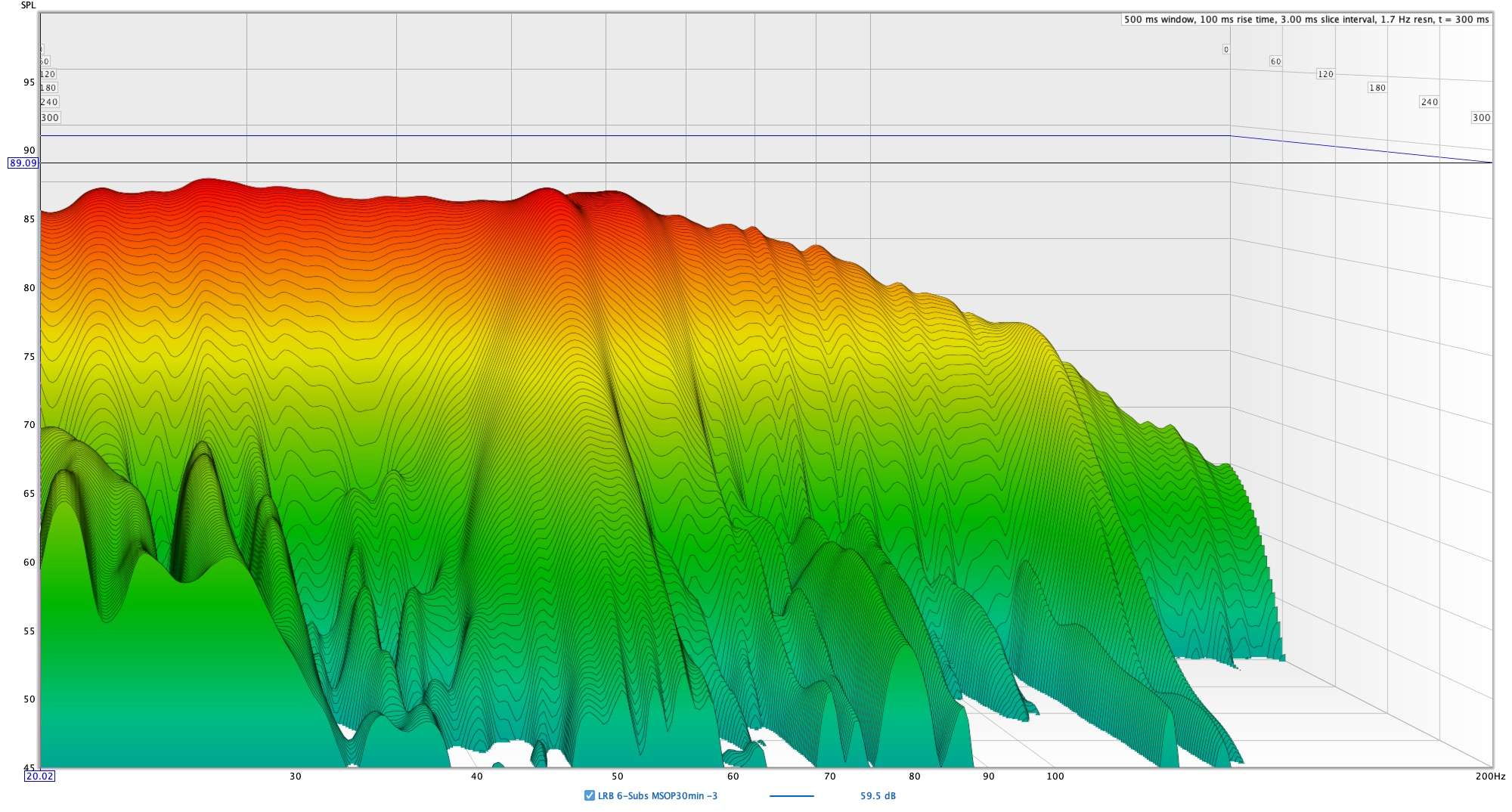 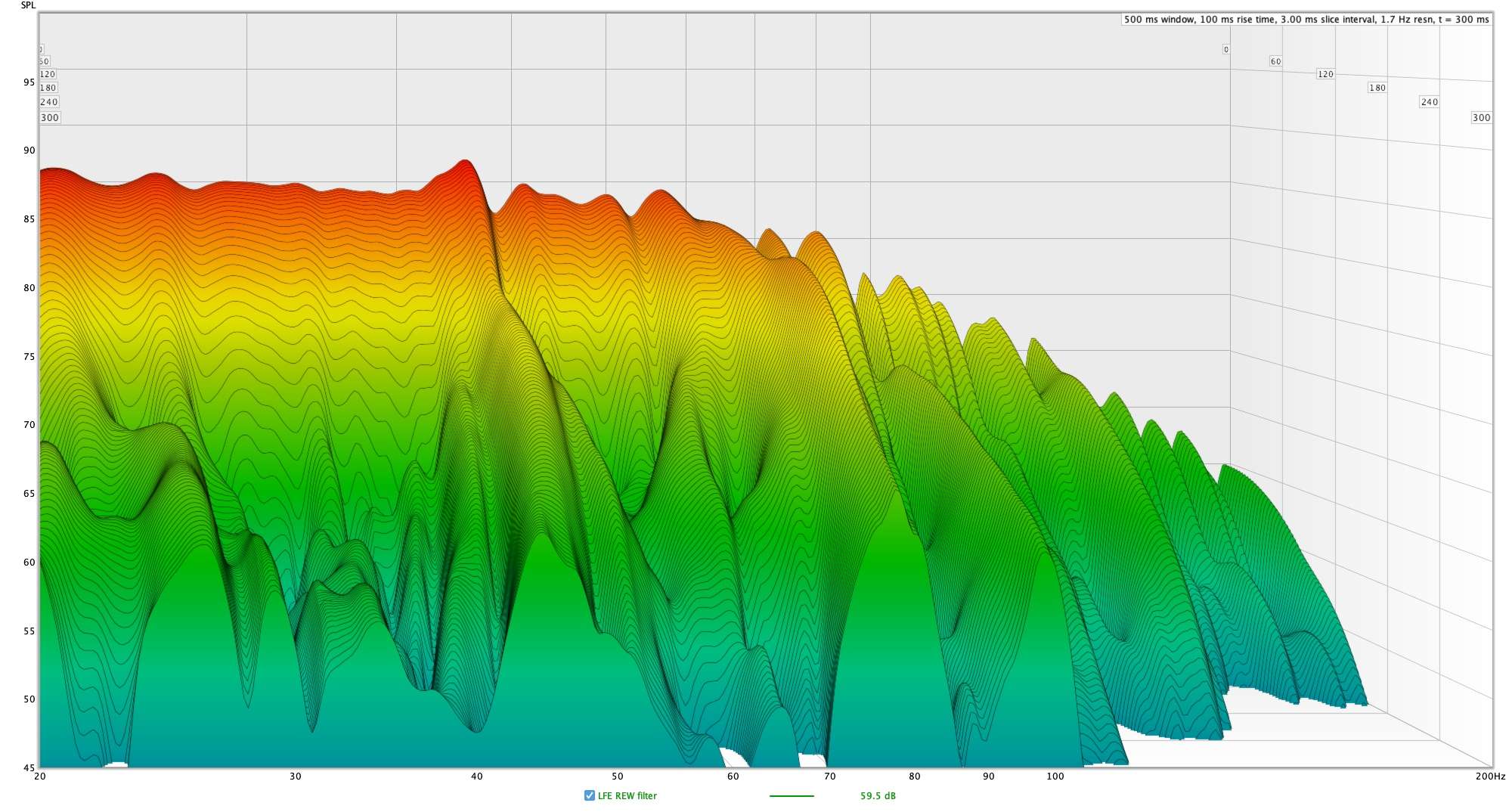 Look how smooth the Blue MSO trace is! It sounds terrible! 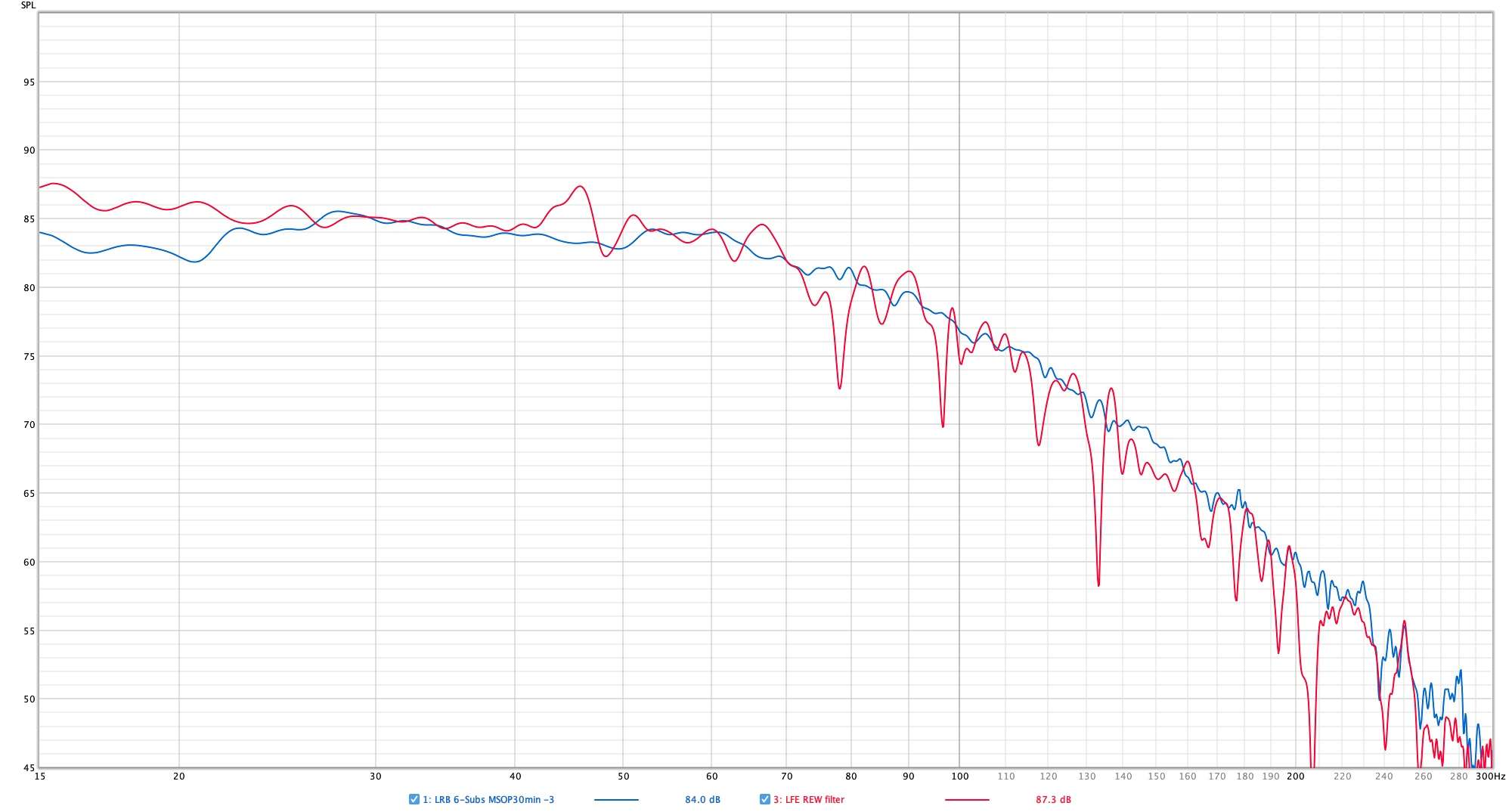 Ok, MSO is a great application. I'm new to MSO and need to try other settings for maybe getting results that aren't quite as good looking. I'll keep trying because frankly, once you get used to how to setup the app - which was a bit frustrating - things went so much quicker. After setting things up a few times it's not bad at all, and once you say GO, you just walk away for a half hour or so and let the number crunching happen. Like REW, the result is surprisingly close to the predicted. So the point here is, be careful about thinking you want it to measure and look great because it may end up sounding awful. |
|
ttocs
Global Moderator    I always have a wonderful time, wherever I am, whomever I'm with. (Elwood P Dowd)
I always have a wonderful time, wherever I am, whomever I'm with. (Elwood P Dowd)
Posts: 8,146
Member is Online
|
Post by ttocs on Feb 5, 2023 13:41:07 GMT -5
This is to show how I use IMPULSE in REW to line up the subs in my system. 6 subs, 3 locations, so it's 3 stacks of 2 subs each. Let me first say that a lot of what and how I do things comes from my own experimentation. When I can't find well explained info out there that I can understand, I just try things, and once in a while I stumble across something useful. After trying various ways to do something, I end up using what I think at the time seems to work well, until I can find another way that's either easier or better, or both. One thing I stumbled upon was the fact that some Sound Modes will have a different amount of delay. Using a Speaker Output seems to have less impact on delay than using a Subwoofer Output with BM (Bass Management) applied to it. So what should we use? I really don't know the answer, but I chose to use Direct and use a Speaker Output. This seems to give the most consistent results when aligning just the subwoofers together. I don't know which way is best, to align when the subs can be measured with the least amount of delay, or the most? So, I choose to use the one with least amount of delay thinking that maybe the others have more processing that I want to avoid during the alignment process, and it seems to work well for me, even though it probably doesn't matter - so long as the same Sound Mode is used consistently. Here is an example of what happens - visually - when adjusting PHASE on a subwoofer. Notice that at 0º Phase the Impulse is inverted, and, the inverted peak is far enough behind the next smaller peak that I believe that by adjusting the phase of the sub I can get that next smaller peak to rise up and become the dominant peak with less delay once it hits 100%. By the time I got to 158º that smaller preceding peak had risen to 100%, so I went a few degrees more so that inverted peak was far enough away from -100% so the newly dominant positive peak would be very stable. Notice the "indicator" named REF, this is where I hover the mouse over so I can see what REW says the amount of delay is and this is the number I use to align the subs. I want the first big peak to be positive without having to invert the phase of the sub, if possible. 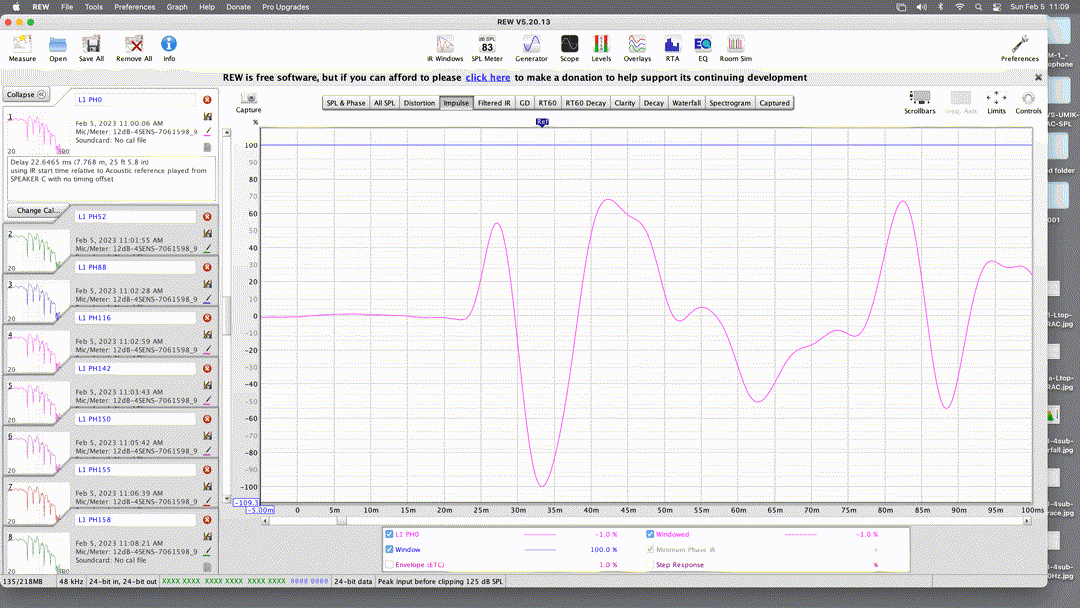 So I first match up both subs in each stack, which may or may not end up with the same phase setting, as can be seen in the image below. See #1 with Phase of 74º and #2 with Phase of 90º, both of which end up with the same delay of 24.3ms.  I ended up adding 1ms delay in the miniDSP so they both would match the delay of the farthest subs with a delay of 25.3ms. Once they all match, the Impulse peaks all line up exactly at the same point. The image below shows just the 3 stacks, but all lined up perfectly. 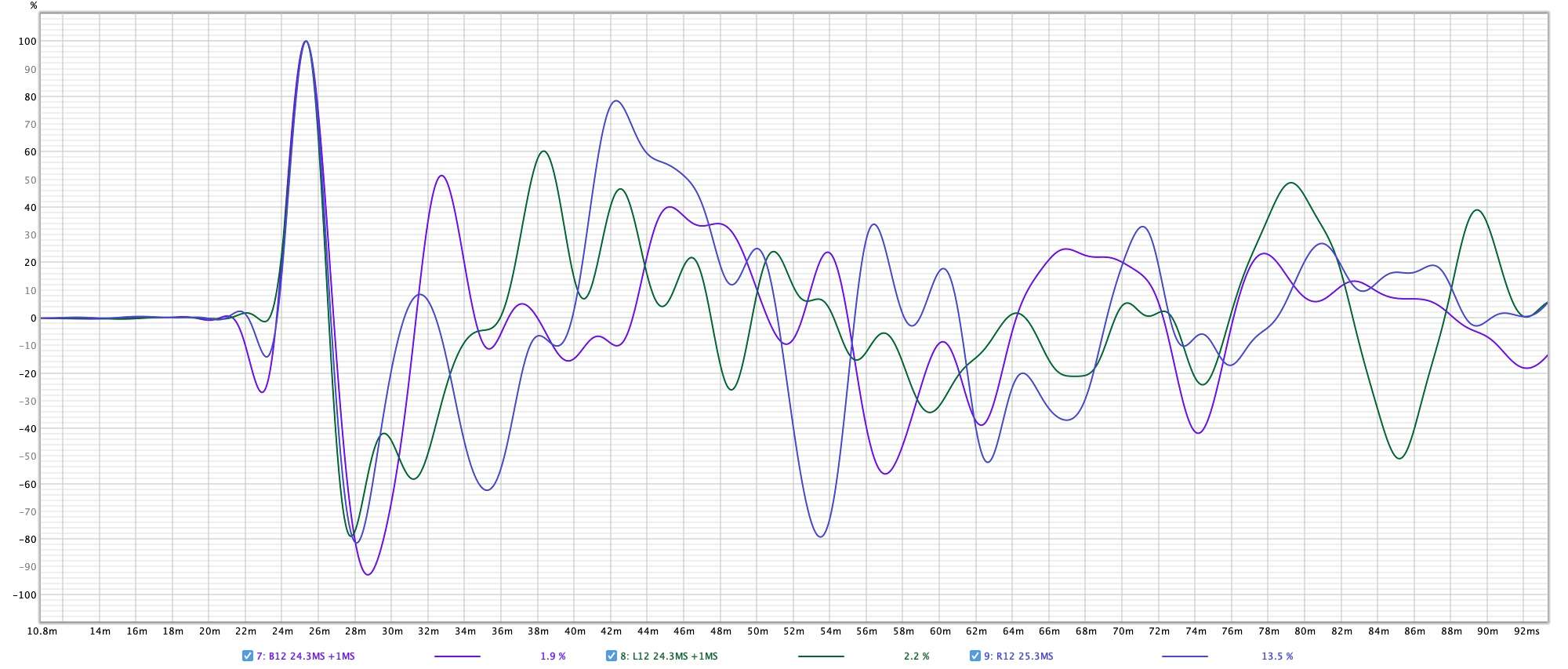 Once all 3 stacks were aligned I ran a sweep and then used EQ in REW to make a PEQ filter that was loaded into the miniDSP. Below is the before/after. I have not yet run Dirac since doing this, but will post the result once I do. Blue=Before, Red=After. You can easily see the amount of reduction of output dictated by the filter. There is no other negative gain involved like there would be if MSO were used, but MSO would produce a flatter response. With Dirac there will be reduced output, but probably only as much as -6dB max. 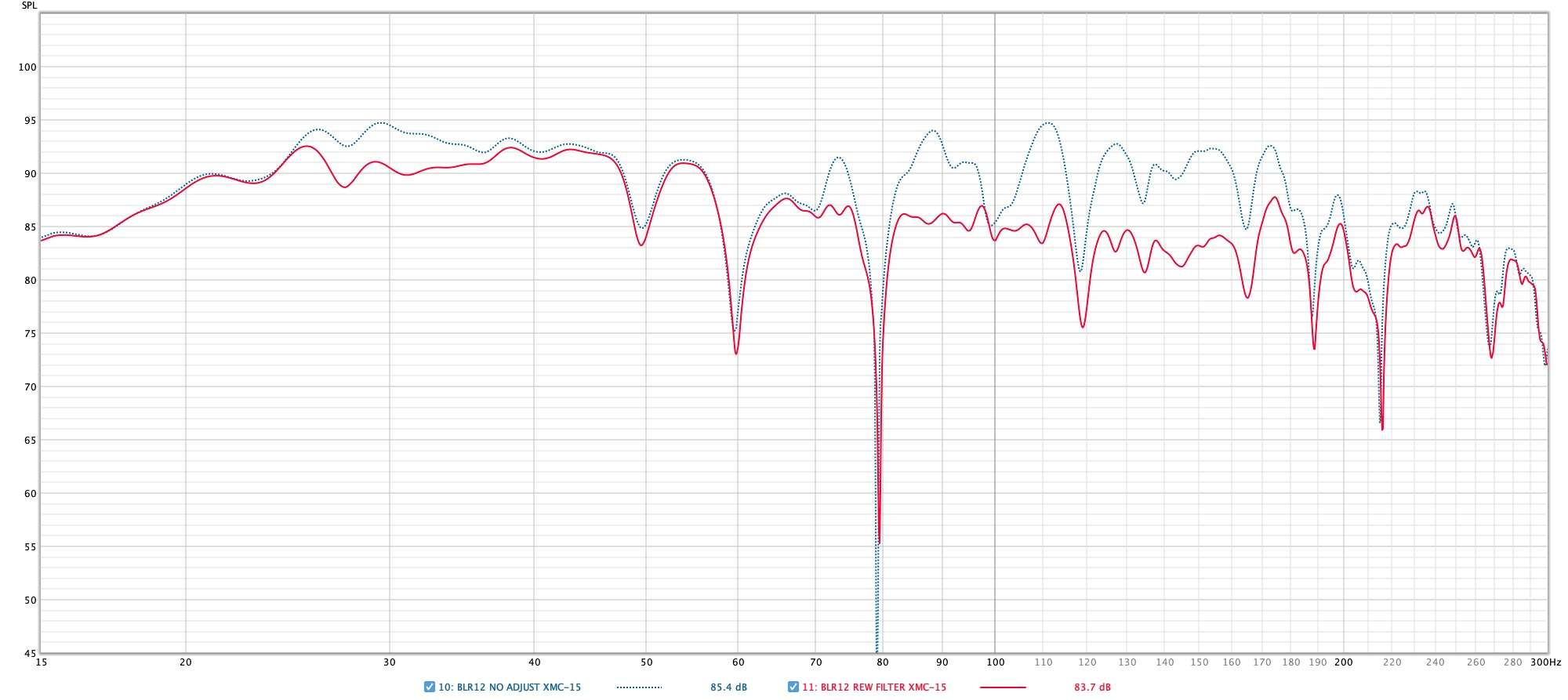 |
|
ttocs
Global Moderator    I always have a wonderful time, wherever I am, whomever I'm with. (Elwood P Dowd)
I always have a wonderful time, wherever I am, whomever I'm with. (Elwood P Dowd)
Posts: 8,146
Member is Online
|
Post by ttocs on Feb 5, 2023 17:19:45 GMT -5
This just shows the variation of Impulse response when using different Sound Modes and Subwoofer Output or Speaker Output. The Speaker Output has less delay and a sharper Impulse peak. I don't think it matters in the long run which output is used, because it should all be relative, but I'm not sure what's going on with the delay differences with sound modes used. I normally use a speaker output when aligning and EQ'ing simply because otherwise, I don't know another way to get a non-rolled-off response. If that rolloff is in a measurement, and one wants to create an EQ filter, then one must account for when the rolloff begins to occur and be sure NOT to EQ above that point otherwise the EQ filter will "try" to lift the rolled off frequencies up as much as it can. So, I set the Fronts as Large, and swap the XLR for the subs over to the Right Front Output. Here's a plot showing some variations in delay with Sound Modes and Sub or Speaker Outputs. It's just one single subwoofer being used here, and when I aligned all the subs I was using the Right Front Speaker Output and Direct Mode.  |
|
ttocs
Global Moderator    I always have a wonderful time, wherever I am, whomever I'm with. (Elwood P Dowd)
I always have a wonderful time, wherever I am, whomever I'm with. (Elwood P Dowd)
Posts: 8,146
Member is Online
|
Post by ttocs on Feb 10, 2023 9:41:56 GMT -5
NEXT REW ZOOM CONFERENCESaturday, February 25, at 4pm EST, 16:00 Hours GMT -5Please PM marcl with your email address so he can send you a link to join the conference.
If you have some topics to suggest, please post them. |
|
ttocs
Global Moderator    I always have a wonderful time, wherever I am, whomever I'm with. (Elwood P Dowd)
I always have a wonderful time, wherever I am, whomever I'm with. (Elwood P Dowd)
Posts: 8,146
Member is Online
|
Post by ttocs on Feb 21, 2023 18:24:23 GMT -5
Reminder: REW ZOOM Conference this coming Saturday at 4pm EST, 16:00 Hours GMT -5. PM marcl so he can send an invitation to you. |
|
|
|
Post by marcl on Feb 22, 2023 11:01:49 GMT -5
I have not received any requests for the Zoom link. If there's no interest, we'll postpone to a later date.
Note that we had been thinking of going deeper into MSO and the REW Alignment Tool this time based on extensive work ttocs has done over the past couple months. If this topic is of interest please PM me and I'll send the link.
If some folks would prefer a different topic - such as basic Dirac calibration and REW verification - let us know.
|
|
ttocs
Global Moderator    I always have a wonderful time, wherever I am, whomever I'm with. (Elwood P Dowd)
I always have a wonderful time, wherever I am, whomever I'm with. (Elwood P Dowd)
Posts: 8,146
Member is Online
|
Post by ttocs on Feb 23, 2023 21:16:46 GMT -5
ZOOM CONFERENCESaturday, February 25, at 4pm EST, 16:00 Hours GMT -5Please PM marcl with your email address so he can send you a link to join the conference.
MAIN TOPIC: Dirac Calibration With REW Confirmation
|
|
|
|
Post by marcl on Feb 24, 2023 13:28:02 GMT -5
Topic will be basic Dirac calibration and verification with REW I'll make it easier ... here's the Zoom login: Join Zoom Meeting us06web.zoom.us/j/86705395587?pwd=Q1ZEcGgzck9uOGZXOUd3YW5ZZDZodz09Meeting ID: 867 0539 5587 Passcode: 039651 We'll each do a live Volume calibration to demonstrate any differences between systems. Then we can load some previous measurement sets, tak about target curves, and do some REW post-calibration measurements. |
|




























